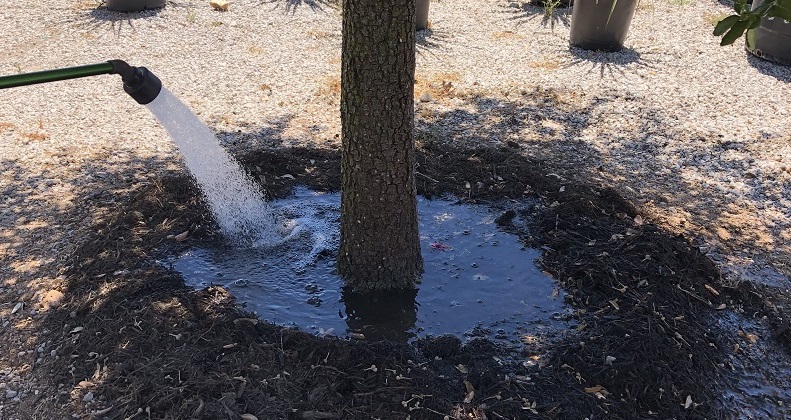Watering:
-Water your tree religiously for at least one year using the following guidelines, and subsequent years during
the hottest months or if we experience high heat or drought conditions.
-At the time of planting the tree needs to be deeply watered. Two days after planting the tree needs to be deeply
watered again. You can do this by turning on the hose and laying it inside the mulch reservoir, about six inches
from the trunk, running it at a steady stream for about thirty minutes. If the reservoir does not fill up evenly,
move the hose to the other side and repeat watering. If you have planted a larger tree, we recommend using a
small sprinkler. Be sure to apply enough water to saturate the entire root ball, to the bottom, and the soil area
beyond.
-Make sure you are saturating the entire root ball and the soil area beyond. Be sure to water deeply and DO NOT
RELY ON RAIN OR SPRINKLER IRRIGATION! Please note that this is just a general watering guideline. If you have
heavy clay soils, it is very easy to overwater a tree and kill it.
Guidelines for Watering Your Tree for the First Year
Temperature Frequency of Watering
90-100 Degrees every day
80-90 Degrees every other day
50-80 Degrees twice a week
Winter once a week
-Clay and other poorly draining soils may not require as frequent watering as indicated above. Overwatering or
trees staying too wet can be as damaging as trees being too dry. The best way to check for soil moisture is to dig
down under the mulch 3 or 4 inches and feel if the soil is moist. Be sure to check the root ball and the
surrounding soil for moisture.
Fertilization:
-We recommend an organic program for the long-term health of your trees. Trees need to be fertilized each
spring and fall with an organic tree and shrub fertilizer such as Microlife Ultimate 8-4-6. We also recommend
applying Microlife Humates Plus twice a year in addition to fertilization. Do not use tree fertilizer spikes.
-1/8” topdressing of premium compost may be applied once a year in the spring or fall around the drip line of
your tree.
-Chemical fertilizers may be used if desired. Follow package directions or ask us for application advice.
-Be sure to spread all fertilizers uniformly around the entire drip line of the tree. Do not concentrate the
fertilizer around the trunk or inside the mulch reservoir. It is very important that you water all fertilizers and
compost applications in well.
Mulching:
-Annual reapplication of mulch is recommended to maintain a 2-3” layer of mulch. We recommend a double grind
shredded native hardwood mulch that has been aged for a minimum of a year. Keep mulch pulled back 3” to 6”
from the trunk.
Weed Control:
-NEVER USE WEED AND FEED TYPE FERTILIZERS OR BROADLEAF HERBICIDES in any areas near trees. You may
apply pre-emergent herbicides that will not harm the tree to prevent weeds from germinating.
Staking and Deer Caging:
– It is the customer’s responsibility to keep the tree staked until rooted well. You may remove the staking when
you can give the trunk of the tree a good shake and you do not see the ground around it move or jiggle at all.
-If you have deer, be sure to put a cage around your tree trunk to keep them from rubbing on the trunks.
We give no warranty, expressed or implied, as to the productiveness or life of
nursery stock we sell and will not be responsible for result secured upon
transplanting
